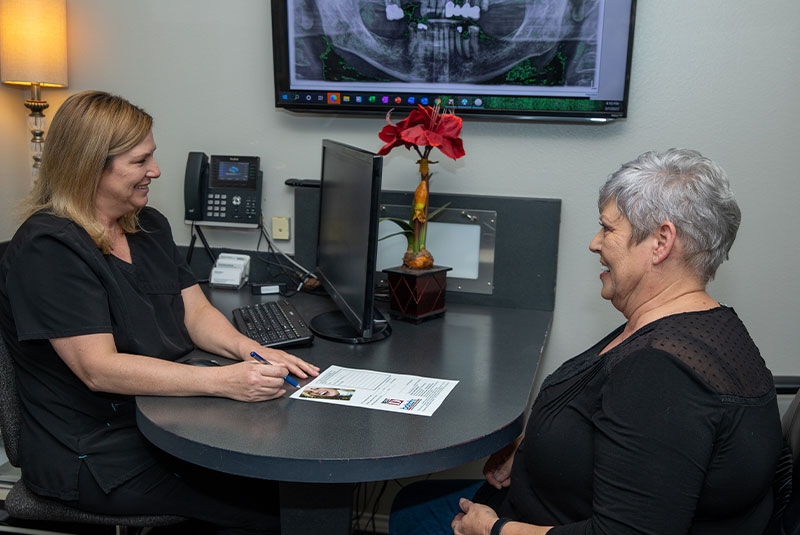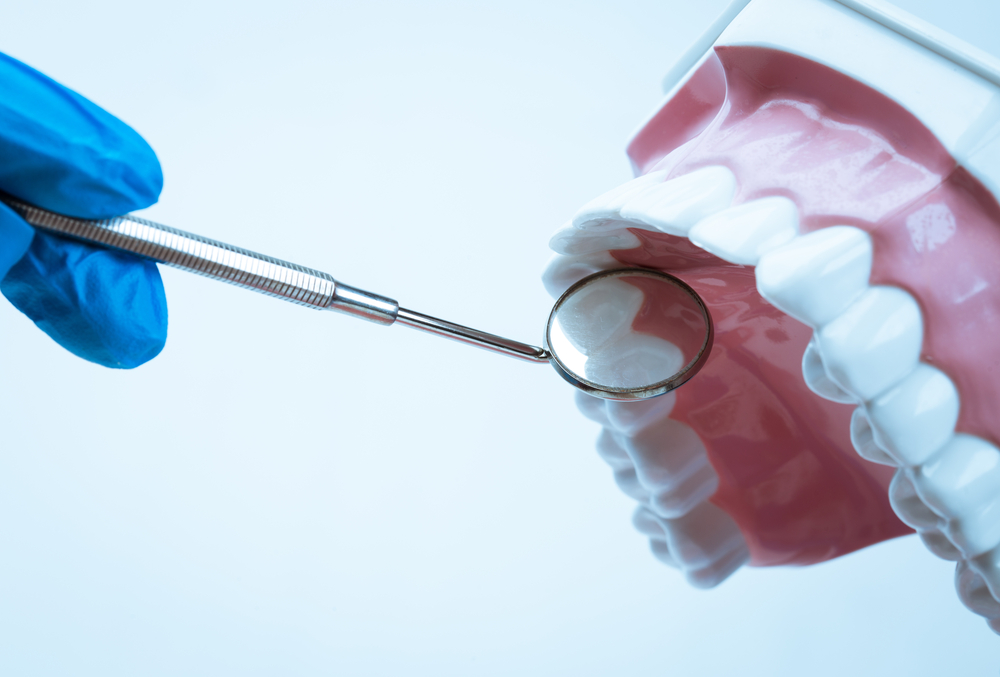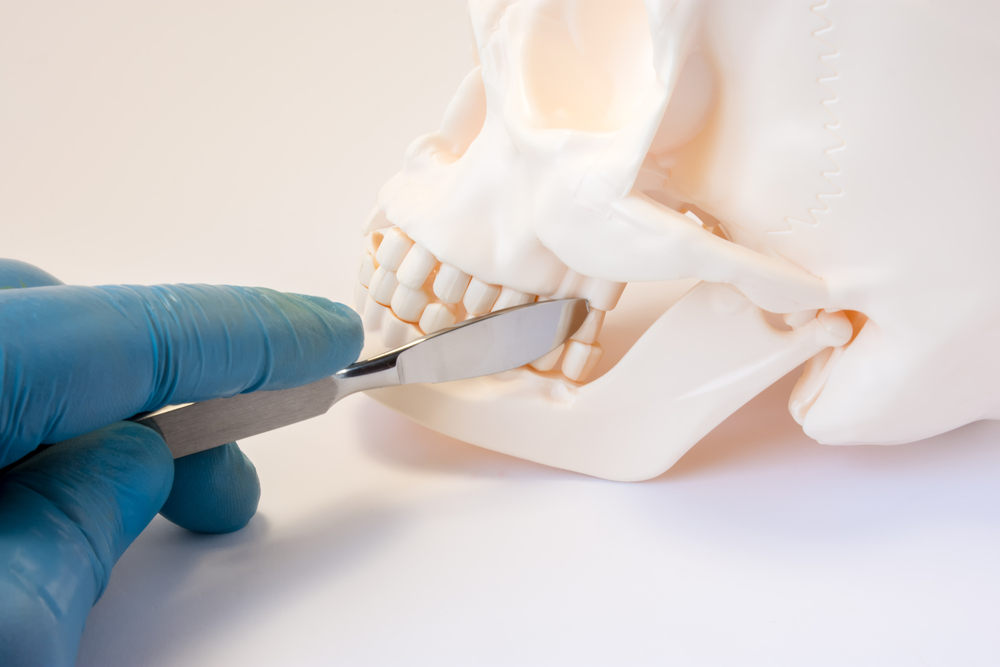

With advanced gum disease, there are often unmistakable signs, including swollen, bleeding gums, deep pockets between teeth, tooth looseness or loss, and chronic bad breath. Surgical intervention, such as pocket reduction or osseous surgery, is crucial at this stage to preserve gum and tooth health.
At DFW Implant Center, our skilled Arlington periodontist, Dr. Farhad E. Boltchi, is trained to diagnose and treat all stages of gum disease, offering expertise in replacing lost bone and teeth. Learn more by dialing 817-663-4704, or if you’re a new patient, call 817-467-7731 and experience the difference osseous surgery can make.
Osseous surgery, also known as flap surgery, is a dental procedure designed to treat advanced gum disease (periodontitis). Osseous surgery aims to eliminate pockets between the teeth and gums where bacteria can accumulate, contributing to the restoration of gum health and preventing further progression of periodontal issues.
During this surgical intervention, your Arlington periodontist lifts the gums to access the roots of the teeth. The goal is to remove diseased tissue, thoroughly clean the roots, and reshape the bone if necessary.




Flap surgery addresses advanced gum disease, reducing the risk of associated systemic health complications such as diabetes, respiratory disease, cardiovascular issues, and stroke.
The procedure effectively clears calculus and bacteria, tackling the root causes of inflammation and infection that contribute to gum disease.
Flap surgery involves trimming away diseased gum tissues, promoting the restoration of healthier gum structures.
Damaged bone is reshaped during the surgery, contributing to the preservation of bone health for future dental well-being.
By restoring health to oral structures, Flap surgery aids in preserving teeth and preventing further deterioration.
The surgery creates a healthier oral environment, supporting better function, enhanced smile aesthetics, and improved overall oral health.
With chronic inflammation addressed, patients experience better overall health and the ability to engage in daily activities such as eating, talking, and laughing comfortably and confidently.
Flap surgery can contribute to reduced tooth sensitivity, enhancing overall oral comfort.
By addressing the underlying causes of gum disease, flap surgery helps prevent tooth mobility, ensuring a stable and functional dentition.
The restoration of healthier gum structures and the elimination of infection contribute to long-term gum health, reducing the risk of future periodontal issues.
Reshaping damaged bone not only preserves the health of the treated area but also provides support to adjacent teeth, maintaining their stability.
Flap surgery can contribute to improved bite alignment, enhancing the overall functionality of the teeth and reducing the risk of bite-related issues.
A healthier oral environment and improved aesthetics can positively impact psychological well-being, boosting confidence and self-esteem.

Osseous surgery is typically recommended for individuals who meet the following criteria:
Flap surgery is most commonly prescribed for individuals with advanced stages of gum disease, particularly when non-surgical treatments like scaling and root planing have proven insufficient.
Patients with deep periodontal pockets, which are spaces between the gums and teeth that harbor bacteria, may be candidates for osseous surgery.
Individuals experiencing bone loss around their teeth due to gum disease may qualify for osseous surgery to reshape and preserve the remaining bone.
Osseous surgery may be recommended for individuals with teeth exhibiting mobility or looseness caused by advanced gum disease.
Chronic gum inflammation that hasn’t responded to conventional treatments may indicate the need for osseous surgery to address underlying issues.
The presence of significant tartar and bacterial buildup, contributing to gum disease, may prompt the consideration of osseous surgery.
Patients who have not experienced satisfactory results with non-surgical treatments for gum disease may be evaluated for osseous surgery.

The first step in the osseous surgery process is the consultation. During this phase, Dr. Boltchi, your Arlington periodontist, assesses your dental and medical history, conducts a thorough examination of the oral cavity, and may order diagnostic tests such as X-rays or CT scans. The goal is to evaluate the extent of bone and tooth loss alone, identify any underlying issues, and determine the most suitable treatment plan.
Once the consultation is complete and the decision to proceed with osseous surgery is made, the next step is preparation. Dr. Boltchi will explain the surgical procedure itself, discuss dental sedation options, and address any questions or concerns. He may also provide pre-operative instructions to ensure the patient is adequately prepared for the surgery, including guidelines on fasting and medication management.
For the osseous surgery itself, Dr. Boltchi accesses the affected area, removes diseased or damaged bone tissue, and may use bone grafts or bone substitutes to augment and promote the regeneration of healthy bone. This step is crucial for stabilizing the teeth and preventing further deterioration of the supporting structures.
Post-operative care is essential to successful osseous surgery. Dr. Boltchi offers the following tips for osseous surgery aftercare:
Take prescribed pain medications as directed by Dr. Boltchi to manage discomfort. Over-the-counter pain relievers may also be recommended.
Apply ice packs to the treated area for the first 24 hours after surgery to help reduce swelling. Be sure to follow any specific recommendations from Dr. Boltchi regarding the duration and frequency of ice application.
Brush your teeth gently, avoiding the surgical site initially. Use a soft-bristled toothbrush and follow any specific oral hygiene instructions provided by Dr. Boltchi. You may be given an antimicrobial mouthwash to use.
Stick to a soft diet for the initial days following surgery. Avoid hot and spicy foods, and opt for cool or lukewarm items. As healing progresses, you can gradually reintroduce harder foods.
Refrain from smoking and using tobacco products during the recovery period. Smoking can impede the healing process and increase the risk of complications.
Restrict strenuous physical activities for the first few days after surgery. Avoid activities that could potentially disrupt the surgical site or increase blood flow to the area.
Attend all scheduled follow-up appointments with your Arlington periodontist. These visits are crucial for monitoring the healing process, removing stitches if necessary, and addressing any concerns you may have.
Be vigilant for signs of infection, such as increased swelling, persistent pain, redness, or discharge from the surgical site. Contact our office promptly if you notice any concerning symptoms.
Drink plenty of water to stay hydrated, which supports the overall healing process. However, avoid using straws during the initial days, as suction can potentially disrupt the surgical site.
Allow your body to rest and recover. Get adequate sleep, and avoid stress as much as possible, as it can impact the healing process.
Be mindful of the treated area. Avoid touching or probing the surgical site with your fingers or tongue. If you were provided with any protective devices, such as a surgical stent, use them as directed.
While osseous surgery is performed under anesthesia to minimize discomfort, some post-operative pain and swelling can be expected. Your oral surgeon will prescribe appropriate pain medications to manage any discomfort during the recovery period.
Osseous surgery aims to stabilize and preserve teeth by addressing bone loss associated with gum disease. While it can be highly successful in saving teeth, the outcome depends on factors such as the extent of damage, individual healing response, and patient compliance with post-operative care.
Insurance coverage for osseous surgery varies based on the specific terms of the plan and medical necessity. Dental insurance may partially cover the procedure if it’s deemed essential for treating advanced periodontal disease.
Pre-authorization is recommended before the surgery, and individuals should inquire about coverage limits, waiting periods, and out-of-pocket costs. Coordination of benefits between dental and medical insurance, if applicable, should be clarified with the insurance provider.
Yes, less invasive treatments, such as scaling and root planing (deep cleaning), are often attempted first to address gum disease. However, if these treatments are ineffective or you’re experiencing more severe gum disease, osseous surgery may be recommended to achieve comprehensive results.
Explore the transformative impact of osseous surgery on your oral health by reaching out to DFW Implant Center in Arlington, TX. For existing patients, contact us directly at 817-663-4704, and if you’re a new patient, take the first step towards a healthier smile by calling 817-467-7731.
Visit our state-of-the-art Arlington clinic for high-quality periodontal care and experience the difference personalized treatment can make in preserving your gum and tooth health. DFW Implant Center proudly serves patients from Arlington and surrounding areas such as Irving, Fort Worth, and Grapevine.
I understand the information disclosed in this form may be subject to re-disclosure and may no longer be protected by HIPAA privacy regulations and the HITECH Act.

800 West Arbrook Blvd
Suite 360 Arlington, TX 76015